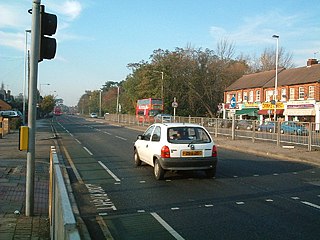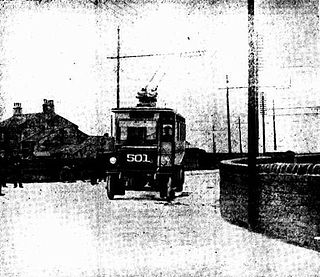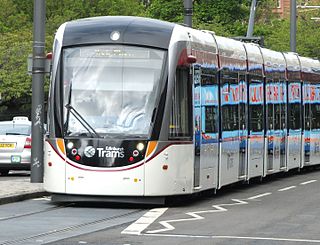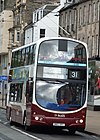
The Melbourne tramway network is a tramway system serving the city of Melbourne, Victoria, Australia. The tramway network is centred around the Melbourne central business district (CBD) and consists of approximately 1,700 tram stops across 24 routes, with more than 500 trams and 250 kilometres of double tram track which served a patronage of 206 million over the year 2017-2018. It is the largest operational urban tram network in the world and one of the most used. Trams are the second most utilised form of public transport in Melbourne after the city's metropolitan commuter railway network.

Manchester Metrolink is a tram/light rail system in Greater Manchester, England. The network has 99 stops along 64 miles (103 km) of standard-gauge route, making it the most extensive light rail system in the United Kingdom. Over the 2022/23 financial year 36 million passenger journeys were made on the system.

The West Midlands Metro is a light-rail/tram system in the county of West Midlands, England. The network has 33 stops with a total of 14 miles (23 km) of track; it currently consists of a single route, Line 1, which operates between the cities of Birmingham and Wolverhampton via the towns of Bilston, West Bromwich and Wednesbury, on a mixture of former railway lines and urban on-street running. The system is owned by the public body Transport for West Midlands, and operated by Midland Metro Limited, a company wholly owned by the West Midlands Combined Authority.

The Sheffield Supertram is a tram and tram-train network covering Sheffield and Rotherham in South Yorkshire, England. The infrastructure is owned by the South Yorkshire Passenger Transport Executive (SYPTE), with Stagecoach responsible for the operation and maintenance of rolling stock under a concession until 21 March 2024,, under the brand name Stagecoach Supertram.

Nottingham Express Transit (NET) is a 20-mile (32 km) tram system in Nottingham, England. The system opened to the public on 9 March 2004 and a second phase, that more than doubled the size of the total system, opened on 25 August 2015, having been initially planned to open two years earlier.

Edinburgh Trams is a tramway in Edinburgh, Scotland, operated by Edinburgh Trams Ltd. It is an 18.5-kilometre (11.5 mi) line between Newhaven and Edinburgh Airport, with 23 stops.
There have been two separate generations of trams in London, from 1860 to 1952 and from 2000 to the present. There were no trams at all in London between 1952 and 2000.

The Edinburgh congestion charge was a proposed scheme of congestion pricing for Scotland's capital city. It planned to reduce congestion by introducing a daily charge to enter a cordon within the inner city, with the money raised directed to fund improvements in public transport. The scheme was the subject of intense public and political debate and ultimately rejected. A referendum was held and nearly three-quarters of respondents rejected the proposals.

The Blackpool Tramway runs from Blackpool to Fleetwood on the Fylde Coast in Lancashire, England. The line dates back to 1885 and is one of the oldest electric tramways in the world. It is operated by Blackpool Transport Services (BTS) and runs for 18 km. It carried 4.9 million passengers in 2022/23.

Edinburgh is a major transport hub in east central Scotland and is at the centre of a multi-modal transport network with road, rail and air communications connecting the city with the rest of Scotland and internationally.

Bilfinger SE is a European multinational company specialized in civil and industrial construction, engineering and services based in Mannheim, Germany.

The Edinburgh Airport Rail Link (EARL) was a proposed rail link to Edinburgh Airport, Scotland. The project was passed by the Scottish Parliament in 2007, but following a change of government, was cancelled in September 2007 on the grounds of cost.

The West London Tram was a proposed on-street light rail line that was to run along the Uxbridge Road (A4020) corridor in West London, England. The scheme was promoted by Transport for London (TfL). It was postponed indefinitely on 2 August 2007, as it was opposed by the then councils of all three bisected London Boroughs.

The Leeds trolleybus system served the West Riding of Yorkshire city of Leeds in England between 1911 and 1928. In May 2016, plans to construct a new system, the New Generation Transport (NGT) project, were refused approval from the UK Department for Transport, following a negative report from the planning inquiry.
Edinburgh Corporation Tramways was a Scottish tram network that formerly served the City of Edinburgh, Scotland. The city used four-wheeled double-decked trams painted dark red (madder) and white – a livery still used by Lothian Buses and the modern light rail Edinburgh Trams.
Trams operated in Edinburgh from 1871 to 1956, and resumed in 2014. The first systems were horse-drawn, while cable-haulage appeared in the city in 1888. Electric trams first ran on systems in neighbouring Musselburgh (1904) and Leith (1905), meeting the Edinburgh cable-trams at Joppa and Pilrig respectively. Electrification meant cable trams last ran in 1923, with through running now possible to Leith and as far east as Port Seton. The various systems were operated by different private and municipal entities over the years; the Edinburgh and Leith systems had been merged under Edinburgh Corporation by 1920, but it wasn't until 1928, after the partial closure of Musselburgh line, that all trams operating in Edinburgh were in the sole control of the corporation. The last electric trams ran in 1956, but electric trams returned in 2014 with the opening of Edinburgh Trams. Many of the trams from the horse/cable/first electric era were built in Shrubhill Works. Two trams have been preserved, a horse tram and an electric tram, built by Shrubhill in 1885 and 1948 respectively. A 1903 Dick Kerr cable-tram has also been purchased for preservation. Remnants of the cable-tram system can be seen in Waterloo Place and Henderson Row, and of the Musselburgh line at Morrison's Haven.

The history of Manchester Metrolink begins with its conception as Greater Manchester's light rail system in 1982 by the Greater Manchester Passenger Transport Executive, and spans its inauguration in 1992 and the successive phases of expansion.

The Edinburgh Tram network operates a fleet of CAF Urbos 3 low-floor trams that were specially designed for use in the city. Twenty-seven were built in Beasain, Spain, between 2009 and 2011.
Neil Renilson is a businessman who works in the travel and tourism industry. He has held high-ranking positions at a number of large bus companies including Go-Ahead Group, Stagecoach Group and Lothian Buses, and is currently a director of Jacobite Cruises and City Sightseeing.
The Edinburgh Tram inquiry was a public inquiry, chaired by Lord Hardie, that was held in Edinburgh to establish why the Edinburgh Trams project incurred delays, cost more than originally budgeted and delivered significantly less than was projected. Its report, which was published in September 2023, put much of the blame for the delays and cost overruns on Edinburgh Council and on various arms-length companies employed by the council, singling out Transport Initiatives Edinburgh for particular criticism.























